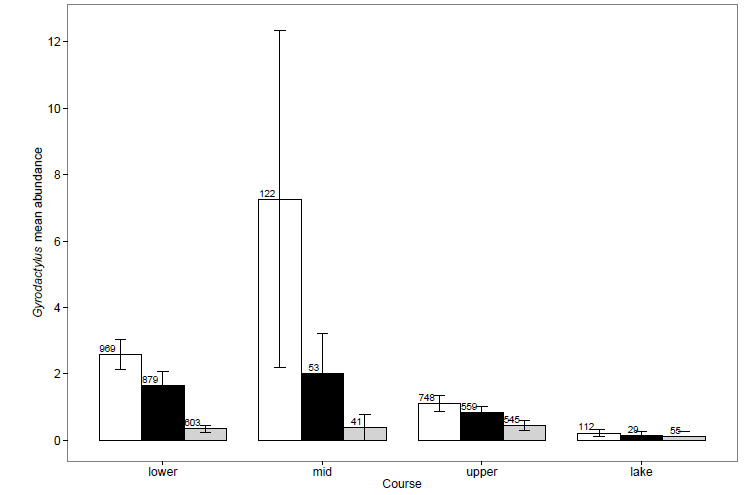
Ecological Archives E096-050-A2
Jessica F. Stephenson, Cock Van Oosterhout, Ryan S. Mohammed, and Joanne Cable. 2015. Parasites of Trinidadian guppies: evidence for sex- and age-specific trait-mediated indirect effects of predators. Ecology 96:489–498. http://dx.doi.org/10.1890/14-0495.1
Appendix B. Figures describing the spatial and temporal pattern in Gyrodactylus infection, predator species richness in each course, and the variation between individual sample sites in Gyrodactylus infection.
Fig. B1. Gyrodactylus spp. mean abundance in fish from the lower, mid and upper courses and the Pitch Lake ('lake'). White bars are data from females, black from males, and gray from juveniles. Error bars are the 95% confidence intervals. The numbers give the total number of fish that contributed to each bar.
Fig. B2. Change in Gyrodactylus spp. abundance over the years sampled in this study. White squares represent data from fish from lower course sites and black squares fish from the upper. The data are the means from all fish sampled and the error bars are the 95% confidence intervals around those means. The numbers on the plot give the overall number of fish contributing to each data point.
Fig. B3. Mean predatory fish species richness (±95% confidence intervals) recorded at each site in each of the four 'course' categories. The four predator species included in the richness score (Polycentrus schomburgkii, Crenichla alta, Hoplias malabaricus and Gobiomorous dormitor) were those we recorded that had a trophic level of greater than 3.5 (Fishbase; www.fish-base.org), which indicates they are generally ichthyophagous (see main text).
Fig. B4. Change in Gyrodactylus prevalence between the first and second time a site was sampled. The sites shown are the only ones from the sample that were visited more than once, and more details are given about them in Table A1.
Fig. B5. Variation between sample sites in likelihood of infection with Gyrodactylus spp. Each data point represents a single sample site: black squares are sites in the upper courses of the rivers; white diamonds are sites in the Pitch Lake; black triangles are mid-river sites; white squares are lower course sites. The vertical line represents the overall mean, thus sites for which the 95% confidence interval error bars do not overlap this line are significantly different from the mean. The lack of a consistent difference between courses may seem counterintuitive given the fact that we found an important difference between the courses by modeling course as a fixed effect. We can reconcile this result because the random effect tests for overall sources of variation, and the 'course' term in the random effect is actually 'site nested within course' and has 42 levels. Individual sites (n = 62) are more variable than sites nested within course, but overall the fixed course effect (with 4 levels) shows us that there is a strong, consistent pattern between courses. The random effect shows that besides a true course effect a lot of variation remains, indicating spatial heterogeneity between sites.